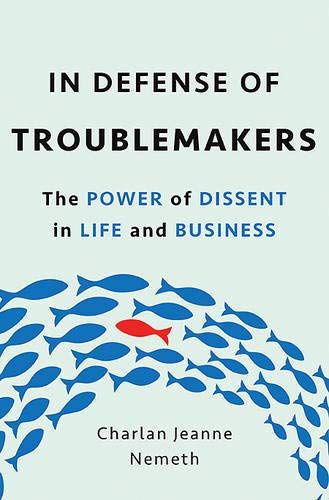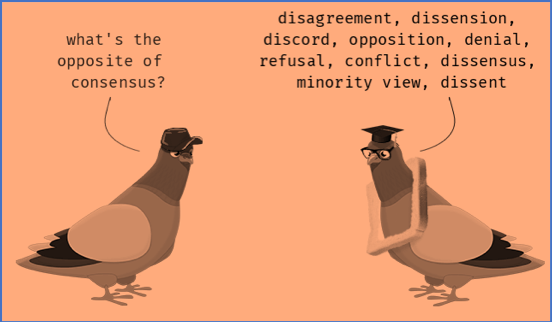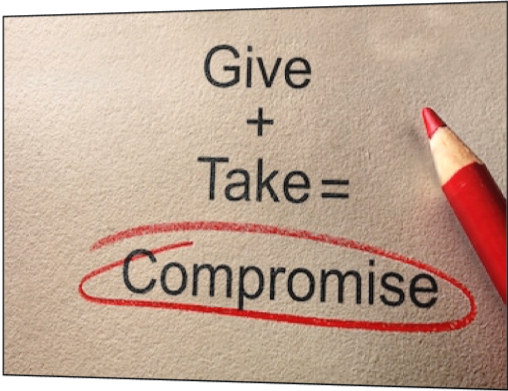by Manuel “Bobby” Orig, Director, ApoAgua
This article is summarized from the book “In Defense of Troublemakers, The Power of Dissent in Life and Business” by Charlan Nemeth, Professor, Department of Psychology, University of California.

Introduction
Dissenters face an uphill battle in getting their voices heard and in their attempts to influence others. Because they are in the minority, they are viewed as obstructionists and inimical to team unity.
But dissenters can actually help you arrive at a sound judgment, and avoid costly and disastrous decisions.
We are wasting a valuable resource when we fail to appreciate the value of listening to the wisdom of dissenters and to capitalize on them. Worse, we face the consequence of making faulty decisions.
I decided to write a summary of the best-selling book “In Defense of Troublemakers” by Charlan Nemeth, because I believe it will enable readers to understand and appreciate the importance that dissenters bring to the table and the perils of decision-making by consensus. Just as important, I want to share with them one of the most reliable guides for becoming a better decision-maker and problem-solver.
I tried to summarize this 204-page book as briefly as I could without losing its core message.
World-renowned author of “Originals” Adam Grant, attests that the book is:
“A timely tome on the perils of silence and the value of voice. Charlan Nemeth is one of the world’s leading experts on decision-making and influencing others and she presents a career’s worth of evidence on why the views you don’t want to hear are the ones you need to hear the most. If you want to escape confirmation bias and overcome groupthink, you need to take dissenting opinions seriously … even if they’re wrong.”
Fear Consensus, Love Dissent

The book is fundamentally about how we make decisions and judgments. In particular, it is about the influence of others on our judgments.
People influence us in a distinctly different manner depending on whether they are a majority and have consensus or whether they are a minority voice expressing dissent.
The more insidious aspect of consensus is that, whether or not we come to agree with the majority, it shapes the way we think. We start to view the world from the majority perspective. Whether we are seeking information, using a strategy in problem-solving, or finding solutions — we think in narrow ways — the majority ways. On balance, we make poorer decisions and think less creatively when we adapt the majority perspective.
On the other hand, dissent, the minority voice, also influences us. Dissenters can also sway us to their positions. Dissent can also sway the way we think about an issue and arrive at our position or decision.
When we are exposed to dissent, our thinking does not narrow as it does when we are exposed to consensus. In fact, it broadens our thinking. On balance, consensus impairs the quality of decision-making while dissent benefits it.
Consequences Of Not Speaking Up

As beneficial as it may be, it is not easy for someone who holds a dissenting viewpoint to express it. We are afraid of ridicule or rejection that are likely to come from dissenting.
Not speaking up, however, has consequences. If the individual does not speak up, the group suffers and misses opportunities. Worse, a group compelled to make quick judgments while operating from only one perspective can make bad decisions, some fatal.
For example, three days before Christmas in 1978, United Airlines Flight 173 was headed from JFK airport in New York to Portland, Oregon. There were 96 people on board. The crew was experienced.
As the flight approached Portland, the time came to lower the landing gear. Suddenly, there was a loud thump and the plane started to vibrate. The crew started to question whether the landing gear was in fact down and whether it was locked. While not knowing exactly what was wrong, they knew that something was not right.
The pilot made what seemed a cautious and wise decision. He decided to abort the landing to check out the problem and determine the best course of action.
For around forty-five minutes, the captain and crew investigated the problem. However, another problem was developing. The plane was running out of fuel. They had more than enough when they left Denver, but were burning it while focusing on the landing gear. They didn’t calculate how much time remained before they run out of fuel because they became blind to this issue.
As the plane run out of fuel, the engines failed one after the other. The plane fell out of the sky. Ten people died. Another twenty-three were seriously injured.
How could this have happened? One important reason the tragedy occurred was that the crew members did not speak up.
Consensus inhibited the expression of dissent and shaped the crew’s thinking to that perspective. The problem was not just where the crew’s attention was focused, but also the information they sought, the alternatives they considered, and the strategy they employed.
Everyone seemed to be in agreement, busily trying to find the problem with the landing gear. No one seemed to appreciate the importance of the low amount of fuel remaining because they only had one focus.
When everyone is focused on one thing, they all lose sight of relevant information and options.
In this example, most people recognize that dissent could have value if it had been correct. If someone has spoken up more forcefully about the diminishing fuel, the crew might have paid more attention to it.
Even then, we know that people do not always follow the truth. Not only does it depend on who holds the truth, but people are more inclined to follow the majority than the minority, right or wrong. What is less recognized is that dissent has value, even if it is not correct.
The value of dissent does not lie in its correctness.
Even when wrong, dissent does two things:
- It breaks down the blind following of the majority.
- More importantly, dissent stimulates thought that is more divergent and less biased.
A Challenge To Popular View Of Consensus
The ideas presented in the book contrast with the common advice which point out to the superiority of the majority or “the many”.
The big concern is that this advice may give the impression that majorities are likely correct, rather than may be correct under certain circumstances.
Most research on this subject has been guided by two tendencies.
One tendency is an assumption that influence flows from the strong to the weak, from “the many” or majority, to “the few” or the minority.
We will see that this is not correct. The ways in which the majority and minority voice persuade others to their position are very different and are manifested in different ways.
The other tendency is to reduce the complexity of the ways in which people affect our thoughts, beliefs, and behaviors to one of persuasion or gaining our agreement.
Reducing the broad area of social influence to persuasion is akin to focus only on winning — getting people to agree with you or to adopt your position.
But persuasion is different from changing the way someone thinks about an issue, and it’s different from stimulating thought.
If upon hearing your position I look at the evidence again and consider the pros and cons of each position and alternative possibilities, you have influenced my thinking. I may not agree with you in the end but you have influenced the way I think and the quality of the judgments and decisions I make.
The best way of assessing quality is to instead assess the quality of the decision-making process.
Good decision-making, at its heart, is divergent thinking. When we think divergently:
- We think in multiple directions
- We seek information
- We consider the facts on all sides of the issue
- We think about the cons as well as the pros.
Bad decision-making is the reverse. It’s thinking convergently.
- We focus more narrowly usually in one direction
- We seek information and consider facts that support an initial preference
- We tend not to consider the cons of the position
- We do not look at alternative ways of interpreting facts.
Perils In Consensus, Value In Dissent

The take-home message of the book is, there are perils in consensus and there is value in dissent. Consensus narrows while dissent opens the mind. Both affect the quality of our decisions.
This message flies in the face of much advice these days. We are told the benefits of liking and being liked, of “fitting in” with the culture. We are told of the wisdom of the majority and the likely repercussions of being different, of “not speaking up” when we disagree.
There are certainly benefits to being liked and to belonging, and there are certainly risks associated with dissent.
What is not often reported is that belonging has a price – our agreement. Paying this price often leads to:
- Unreflective thinking
- Bad decisions
- Reduced creativity.
Some genuinely believe in the majority position but they are still influenced by the incentive to agree and belong, which leads to groupthink. When groupthink takes over, we can lose the value of:
- Each individual input
- The experiences and opinions each can bring to bear on a decision or problem
- More importantly, we can lose the stimulating properties of dissent.
People don’t like it when you argue another position. We get irritated when people disagree with us. But studies show that the challenge dissenters pose makes us better decision-makers and more creative problem-solvers.
Studies also show that:
- these benefits do not derive from a diversity of demographics (age, gender, race, and so on), nor from education and training.
- These benefits accrue from dissent, from being challenged. We benefit when these dissenting views are authentically held and are expressed with conviction over time.
Majorities Versus Dissenters: The Art Of Persuasion

Getting people to agree with you is an art — the art of persuasion.
It turns out that the majority has an enormous advantage. In fact, their power is so immediate and compelling that we follow them even when our senses tell us they are wrong.
Minority views, on the other hand, have an uphill battle to persuade us. In fact, we find many reasons to resist disagreement. Dissenters — “the few” — don’t persuade immediately. It has to be done over time. When we do agree with the minority rule, it is usually due to a real change in attitude.
Majorities have an enormous advantage to get us to agree with them. That power is direct and pervasive. That they win doesn’t mean that they are necessarily correct. Rather, it means that majorities exert immense pressure on our thoughts and feelings, as well as our judgments and decisions. This is especially true when they are unchallenged.
Following the majority can make sense if we think that the majority is right. They may be right, and they often are, but they are not necessarily right. The problem is that we assume that they are right simply because they are the majority.
Independence of judgment is another critical element. The average judgment of a large number of people can be accurate provided their judgments are independent. Herding behavior, for example, demonstrate that many people doing the same thing is not necessarily an indication of accuracy or good judgment.
The problem is not that the majority is wrong. The problem is that we assume that they are right simply because they are “the many” rather than “the few”. The problem is that we make this assumption and then agree to follow — often unreflectively.
What if everyone expressed a judgment that you knew was not true? You might think that you would not care what they said or did and that you would answer correctly, especially if you could see the truth with your own eyes. Research, however, clearly demonstrate that the truth is no protection against the majority.
A classic study on this phenomenon was conducted in 1951 by the influential psychologist Solomon Asch.
In Asch study, individuals were shown two slides side by side. One slide showed a line that served as the standard for the experiment. The other slide had three lines for comparison, one of which is equal in length to the standard line. People were shown a series of these slides. Their task was simply to pick a line that was equal to the standard line. One comparison line was exactly equal to the standard, while the two other were noticeably longer or shorter. Alone, people had no difficulty in judging the right answer. It was obvious.
In one of the experimental conditions, the researcher brought in groups of seven to nine individuals, only one of whom was an innocent participant. The others were paid accomplices of the experiment. They formed a unanimous and incorrect majority. The question as stake was whether the naïve participant would follow the majority and give the wrong answer.
Imagine you are the naïve participant. You see the slides. It is clear that line B is the correct answer. You hear the judgment of one person saying it is “A”. You brush him off, maybe he just has poor vision. The second person says “A”. Now you start to perk up. A third says “A”. This continues. Now it’s your turn. What would you do? Asch’s result showed 37% agreed with the majority’s incorrect judgment.
Asch was not simply interested in manipulating situations to increase or decrease the magnitude of this effect. He wanted to know why people follow the majority even when the majority is in error.
Interviews with Asch’s subjects revealed — and the subjects of many similar experiments have corroborated — two main reasons why people follow the majority:
- One is an assumption that truth lies in numbers.
- The other reason is the desire to belong — or conversely, the fear of being different and of inviting ridicule or punishment.
This fear of being in the minority manifests itself in workplaces as well. For example, Kathleen Ryan and Daniel Oestreich have found that around 70% of employees don’t speak up when they see problems. The research suggests two reasons:
- One is that employees think that speaking up won’t matter and the company simply ignore what they say
- The other is fear of the majority — fear of those who remained silent and did not report the problem. This is clearly the fear of repercussions, such as ridicule and rejection.
Silence then becomes part of the power of the majority.
Finding Independence

With all the powers of the majority to get us to follow and agree, it may not seem obvious that the majority has a weakness. That weakness is their reliance on consensus, especially when challenged. Therein lies the power of dissent to liberate us to think independently.
Unanimity may be the most important variable affecting the majority’s power. Just one person challenging the consensus can break that power and increase our ability to think independently and resist moving to erroneous judgment.
Confronting what we believe at the front end is a buffer against such blind following.
Even better for breaking the hold of the majority so that we think for ourselves is to break the source of their power — consensus. Asch’s length-of-line study provided that breaking the consensus is the route to independence. If the individual had an ally, he was much less likely to follow the erroneous majority. An ally gives us confidence and courage, and support us. With someone on our side, we are better able to speak up.
What may be more surprising is that having an ally is liberating not because of their support but because the consensus is challenged. What if the dissenter is not an ally? What if she’s wrong, even wrong than the majority? You would probably think that she would be of no help. However, the evidence shows that even here, we are liberated. We are more independent. With any break in unanimity, the power of the majority is seriously diminished.
Consistency Held With Conviction
Dissent entails risk. If you dissent, you will get attention. You will be questioned and pressured to change your mind. You will be reminded that you are in the minority with the implication that you are wrong. You are likely to be disliked and rejected.
Is it futile if we hold the minority viewpoint? Even if we recognize that we could help others think more independently, can we ever prevail? Can we ever get them to agree with us if we are one of “the few.” If so, how?
The early studies in social psychology on the topic of influence assumed that it was the majority and not the minority who persuaded others. Thus they studied dissenters only as the target of influence, not the source of influence. Being the target of most of the communication was seen by most researchers as one of the risks of being a dissenter. The dissenter was pressured and rejected.
Yet the researchers never asked whether the dissenter changed the minds of the majority.
How do a lone individual persuade? How do they gain agreement to their position? Research shows that a necessary condition is that the dissenter be consistent in his position. He cannot capitulate or be inconsistent. He cannot compromise if doing so implies change in his position.
The overriding conclusion is that consistency is what is important. Without consistency, there is no clear position held with conviction. Without consistency, a minority voice does not persuade.
The Art Of Consistency And Compromise
While the importance of consistency is underscored in research studies, the concept has been refined beyond a matter of simple repetition. A dissenter can become more artful in articulating his position. Indeed, he can be seen as consistent even if he changes his position, but only in response to new or changing information. He cannot be seen as capitulating. Capitulation renders him ineffective.
With this perspective, it is worth reexamining the lives of martyrs, who, if nothing else did not capitulate. They were willing to die for their convictions. Would they have the same impact if they tampered with their belief?
The research suggests that consistency is more effective than compromise in changing minds. But what about the extensive research supporting the common advice that compromise is needed to get public movement of your position – to make a deal?
The Two Faces Of Compromise

We need to make a distinction between changing attitudes and negotiating a deal.
If you want to make a deal, you usually have to compromise.
But if you want to change minds, compromise is a bad strategy.
What compromise does is make you better liked — or, more precisely, less disliked. But liking is not the determining factor for a dissenting opinion to be persuasive.
Research repeatedly shows that dissenters have “hidden” influence. In general, they change attitudes in private than in public. They change minds.
This pattern has surfaced in many studies. If the dissenter doesn’t compromise, agreement is rarely reached. The majority will not budge. They just get irritated. However, the repeated pattern is a change in attitudes.
Once we recognize that dissenting views change more minds and hearts than is publicly evident, we begin to understand our power in “speaking up” or being the person who dares to challenge the consensus.
Routes To Bad Judgment And Decisions

Our decision-making can go awry when we agree without reflection – that is when we follow others right or wrong. We often do this when facing consensus, which can put us on automatic pilot.
The power of consensus to stimulate single-perspective thinking is one reason why groups make mistakes and bad decisions — even fatal one.
In many real-life examples, the consensus involves a combination of people, some of whom might be leaders while others are followers. To be sure, the leader or authority figure can be important in creating a culture of agreement, but it is consensus that give it power.
While the leader can try to mandate consensus, groups are very capable of creating consensus on their own and punishing dissent. However it is achieved, there is power in consensus for it changes how people think.
Biased Thinking And Bad Decisions
If we were to list the ways to make bad decisions, it would include:
- A narrow and biased way of thinking
- You don’t consider a broad array of objectives or multiple courses of action
- You select information that takes one perspective
- And you concentrate on the pros of that position, avoiding the consideration of the cons or of alternatives. You filter everything through that perspective.
You begin with a narrow search for information that corroborates a single preferred position. Majority is often enough to stimulate this biased kind of search. Rather than search broadly, you actively seek information that will corroborate and thus convince you of the truth of that position.
Many of the reasons for this biased search for information are the same reasons why we follow or agree with the majority. We start with an assumption that the majority is correct or knows something that we do not. We also want to belong.
It is worth reflecting that many of us live in information bubbles characterized by consensus. Our religious and cultural upbringing may have included only family and friends who are in ideological agreement.
We add to this bubble by choice — our choice of friends or news outlets that agree with that upbringing. We end up living in a world of relatively like-minded people that can lead to strongly-held beliefs and a lack of reflective thought about their downsides.
Biased Focus And Problem-solving
Much like decision-making, problem-solving usually benefits from multiple approaches. If we take only one approach to a solution, we had better hope it is the right strategy. If the crew of United Airlines Flight 173 had considered several approaches to the problem, they probably would have thought about the low level of fuel.
Taking multiple approaches is the first step. It doesn’t ensure that you will find the correct solution, but it greatly increases the likelihood compared to taking a single approach. Luckily, the wisdom of a solution or decision is often reasonably apparent once you consider multiple possibilities and seriously analyze each.
When a majority uses a particular strategy, we tend to use it simply because it is the strategy of the majority. Worse, we tend not to use other strategies. Thus we don’t just follow the majority — we think like them. It leads to poor problem-solving, for we limit our strategies as well.
In general, decision-making and problem-solving benefit from a broad search for information and broad consideration of alternatives.
The larger issue is that, when we follow the majority’s way of thinking or strategy to solve a problem, we are less likely to pay attention to other information or to a different problem that may arise. We are less likely to use multiple strategies to solve the problem.
The Search For Information – Pros And Cons

As a rule, we are not generally open to information that opposes our beliefs, especially when we are convinced that we are right. We favor information that confirms our own beliefs.
When we face consensus that disagrees with out position, however, we do the opposite of what we would normally do. In a powerful twist, rather than look for support for our position, we prefer information that confirms the consensus. We don’t look at both sides. We take the consensus perspective rather than our own and primarily seek information that supports the consensus position.
In contrast, in the presence of dissent, we don’t narrow our search to any one position, whether our own or that of the dissenter. Instead, we expand and widen our search. We seek information on both sides of the issue and consider the cons as well as the pros of positions, including our own.
For example, in a study university students were given the results of a survey on proposals they opposed. They were then provided an opportunity to read information favoring or opposing the proposals. The results showed that the information they chose to read was strongly affected by the percentage of students who took the opposite stance, that is, who favored the dreaded proposals.
When a large majority favored the proposals, participants wanted to read information that could explain and confirm the majority position.
But when only a minority of the students favored the proposals — that is, where there was a dissenting position — the search for information was quite different.
When participants learned that a minority of individuals favored the dreaded proposals, they wanted more information in general. They wanted to read more articles as well as longer articles, and their search for information was greater than in any other condition.
Of particular importance, they wanted to see the reason for both viewpoints. There was no evidence of bias in their choice of information to read. They were interested in learning the lessons why people favored the proposals as they were in learning the reasons why people opposed the proposals. They wanted information that supported their own position as well as information that opposed their position. The results held whether or not the proposals affected them personally.
We have seen that the simple fact of an opinion being either in the majority or minority has very different effects on people. When it is a majority, we take their perspective. We narrow the information we seek and how we approach a problem.
Dissent, on the other hand, is one of the most powerful forms of influence for the liberation of thought. When faced with a minority opinion, we seek for information and look at problems from multiple points of view — not just the minority’s point of view, and not just our own. On balance, we make better judgments and are able to detect new solutions. We even think in more original ways.
Groupthink – Straining For Consensus

Groups often operate in a way that “strains for consensus”, a term described by Harvard psychologist Irving James as “groupthink.” As his description of some major political fiascos shows, such strain has been behind some truly poor decisions.
One of the best-known decision fiascos was the ill-fated US-backed invasion of Cuba at the Bay of Pigs.
That decision has been a staple of academic research into the failings of groups and is still enormously illuminating especially through the lens of consensus and dissent.
“Straining for consensus” is basically the definition of “groupthink”. Groupthink, in Janis’s words, is “the mode of thinking…when concurrence seeking becomes so dominant…that it tends to override realistic appraisal of alternative courses of action.”
The antecedents for this strain for consensus includes cohesion, a directed leader, high stress, and little optimism within the group for a solution better than the leader’s preferred position.
And perhaps more important, the consequences of these symptoms are the elements of bad decision-making:
- An incomplete survey of alternatives and objectives
- Poor information research
- Selective bias
- Failure to examine the risk of the preferred choice.
These are all elements of “convergent thinking”. The Bay of Pigs incident is a classic example:

“Ever since Fidel Castro overthrew General Fulgencio Batista and took over Cuba in 1959, relations with the United States had been so poor — so much so that in the early 1960’s there was US interest in overthrowing his regime. Those who had fled Cuba were willing to fight for the cause. President Dwight Eisenhower had approved a plan in 1960 to train these exiles, and the new president, John F. Kennedy, was presented with it. In 1961, the decision was made to use CIA-trained Cuban exiles to invade Cuba. They did so on April 17, 1961.”
The chronology of that invasion would be comical had its consequences not been so serious. The invasion force immediately came under heavy fire. Cuban planes strafed the invaders, sank two escort ships, and destroyed half of the exiles air support. The Cuban exiles were surrounded and captured almost immediately. In the aftermath, the US government was publicly embarrassed.
Reportedly, Kennedy said at the time, “How could I have been so stupid as to let them proceed?”
According to the groupthink model, one antecedent of the strain for consensus is a highly cohesive yet insulated group. The cabinet-level decision-making group that made the Bay of Pigs decision was such a group.
Another antecedent is a “directed leader” who lets you know his preferred position practically from the outset. In the Bay of Pigs decision, President Kennedy favored the invasion and everyone knew it.
Believing they were bigger, stronger, and smarter than the adversary, the Kennedy team grossly overestimated the Cuban’s willingness to overthrow Castro and grossly underestimated the Cuban military.
The Bay of Pigs decision was characterized by a biased information search, inadequate consideration of the alternatives to the invasion, and a failure to examine the risks of an invasion.
The other symptom of groupthink is more important. It can be summarized as shutting down dissent by direct pressure on dissenters. Another is self-censorship. Both are facilitated by self-appointed mind guards.
The president’s brother, Bobby Kennedy, was one of those mind guards. He put pressure on those who seemed to have doubts. For example, he knew that Arthur Schlesinger, special assistant to the president, opposed the invasion. He took Schlesinger aside and asked him why he was not in favor. After listening, Bobby Kennedy said, “…the President has made up his mind. Don’t push it any further. Now is the time for everyone to help him all they can.”
Schlesinger later regretted censoring himself. “I bitterly reproached myself having kept so silent during those crucial discussions.”
Group Pressure Suppress Diversity
Group pressure, by and large, conspire to suppress the very diversity of viewpoints that we seek. As we interact with others, we start to develop a shared view of an issue. Whatever differences we have in the beginning become fewer. It is not just that we want to conform or agree with the majority opinion. It is that the group interaction conspire to limit the range of information considered by the group.
It is our desire to seek agreement, coupled with some group processes, that contributes to poor decisions. Groups make us more like one another, more uniform in our opinions, and more prone to making faulty decisions. What all groups have in common is that they either start with relative homogeneity of opinion or they manage to create it.
Communication And Pooling Of Information
In the Bay of Pigs fiasco, polarization was likely operating. The like-minded individuals who leaned toward invasion became more convinced and extreme in this view and eventually they decided to implement that course of action
Another reason why polarization likely occurred is because of the information they shared or did not share — while they were discussing the issue and making the decision.
A well-researched phenomenon in groups is that individuals share information they have in common. Individuals are less likely to share information that is unique to them. If one person, or only a few, have certain information, it is less likely to be expressed and thus less likely to be part of the decision-making process.
The tendency of groups to discuss primarily the information they have in common is one reason why groups can move too easily to consensus, and it was one reason President Kennedy and his advisers made their disastrous decision to invade Cuba. Information that would have cast doubt on the success of this course of action or that favored an alternative was not shared in that group.
Dissent, by definition, is a minority position, and the information that informs it is relatively unique. Being unique, this expression is less likely to be expressed, less likely to be repeated, and less likely to enter the pool of information that will decide the outcome.
Better Decisions And Devil’s Advocate
In principle, groups have more resources than individuals — more information, experience, and perspective. Yet groups can operate as less than the sum of its parts when:
- Not all of those resources are brought to bear
- Not all information is expressed
- And not all opinions are aired.
The march to consensus favors the majority and what the individual members know and believe in common. Thus, there can be a rush to judgment. Consensus leads to individuals to view information and opinions through the prism of “the many”. It should be no surprise that the resulting decisions can be poor, and can sometimes be deadly.
Some people maintain that the real key to making good decisions is diversity or some kind of technique that plants dissent without needing a true dissenter. That gave rise to the idea of commissioning someone to play the devil’s advocate.
The Downsides Of Playing Devil’s Advocate
The origins of playing devil’s advocate lie in the practice of the Roman Catholic Church when considering a candidate for sainthood. Understandably, the Vatican doesn’t want to make a mistake. They don’t want to learn later that the candidate for sainthood behaved in a way that were not saintly. Thus, in 1587, they instituted a practice of exploring everything negative about the candidate.
Proponents of the devil’s advocate seem to assume that a “nice” version of the dissent — playing devil’s advocate is more likely to invite consideration of the dissenter’s opinion.
The author had been skeptical of the devil’s advocate technique. It seemed to her to be a contrivance. Anyone can undertake an intellectual game, but this is not the same as really thinking through all the pros and cons of something we believe.
The author has studied the power of authentic dissent for years and saw its ability to stimulate:
- A broader search for information
- A consideration of more alternatives
- And the usage of multiple strategies and more original thinking.
Upon reflection, the author and her research team have identified some of the problems inherent in the devil’s advocate technique:
- Role-playing does not show the courage and conviction of authentic dissent
- When a person is role-playing, you don’t really know the relationship between what he is saying and what he believes
- Even when his words are consistent with his beliefs, you know he is acting. And since you are aware that he is playing a role, you are likely to think and interact with him differently.
Regardless of the reasons, the devil’s advocate, unlike authentic dissent, does not stimulate the kinds of thinking that lead to good decision-making or creative problem-solving.
Even the Roman Catholic Church, in a historical turnaround, has started to embrace dissent, abandoning its reliance on the devil’s advocate method. When the route to sainthood was streamlined in 1983, the church eliminated the traditional position of devil’s advocate.
Conclusion

The underlying message of the book is twofold:
- Consensus, while comforting and harmonious as well as efficient, often leads us to make bad decisions.
- Dissent, while often annoying, is precisely the challenge that we need to reassess our own views and make better decisions. It helps us consider better alternatives and generate creative solutions.
So why do we punish dissent? Most of us believe that we are open to differing views. Some of us believe that we like challenges to our ideas. In practice, however, most of us dislike a person who believes the opposite of the position we hold. We tend to think of him in negative terms and blocking our goals. We are quite willing to punish him often through ridicule or rejection.
We are continually advised to “go along and get along”. It is a powerful advice for most of us who prefer to be “in” rather than “out”. We like being accepted and valued – and we know that if we stand up against the majority, we will be “on the outs”. We thus remain silent.
The book applauds dissent, not for the truth it may hold, but for its impact on the way we think. Confronted by dissent, we are less likely to rush to judgment, whether as individuals or in groups. We are more likely to consider the pros and cons of a position. Dissent, by and large, helps us make better decisions and come up with more creative solutions.
There are downsides to dissent, to be sure. Dissent increases conflict and sometimes lower morale. It takes us longer to discuss options and analyze them. However, there is a trade-off. As long as dissent is authentic, it becomes a mechanism for reexamining our positions and looking more extensively for information. These beneficial outcomes occur even if dissent is wrong.
Best of all, genuine dissent and debate will not only make us think well. We make better decisions, find creative solutions, and are better able to render justice.
There is wisdom in listening to dissenters.
Did you enjoy this article? Do you want to suggest a topic on leadership?


